The international community now fully recognizes the need to secure women’s land rights. The Sustainable Development Goals, the world’s blueprint for development, include women’s land ownership and secure tenure rights as indicators for poverty eradication (Goal 1), ending hunger (Goal 2), and gender equality (Goal 5). The first international land governance standards and principles agreed upon by states, the Voluntary Guidelines on the Responsible Governance of Tenure of Land, Fisheries, and Forests in the Context of National Food Security, call upon states to “ensure that women and girls have equal tenure rights and access to land, fisheries and forests independent of their civil and marital status.” Regionally, the African Union, for example, has declared a goal of 30 percent of all registered land being in a woman’s name by 2025. Policies and interventions on land titling and land registration in developing countries increasingly mandate or promote joint titling of household land in the names of both spouses or registration in the name of women individually.
Land titles are often used as a proxy for women’s land tenure security. But while getting land registered in a woman’s name is important, evidence demonstrates that focusing on titling alone—whether individually or at the household level—may not necessarily lead to greater tenure security for women. It can instead do just the opposite.
To ensure tenure security, the development community, policymakers, and practitioners must expand the range of interventions that address internal and external constraints women face when exercising their land rights.
This Commentary highlights challenges women face in securing land rights and identifies ways to address them. It offers policymakers, development agencies, donors, land rights NGOs, practitioners, and researchers a snapshot of the land tenure landscape that can inform policies, interventions, advocacy, and research on women’s land rights. It describes the benefits of securing tenure for women and the pitfalls of titling alone, with examples of country initiatives and alternatives to land titling that ensure tenure security for women. This Commentary builds on previous World Resources Institute (WRI) research and will be followed by a WRI report later this year that examines the conditions for securing women’s tenure rights in collectively held land.
Benefits of Securing Women’s Land Rights
Advocacy for women’s land rights is rooted in significant evidence of the benefits. These benefits include improved well-being for women and their families, women having a greater say in household decisions, better child nutrition, and higher children’s school enrollment and health investments. Research also shows that secure rights to land enhance women’s status in their community and empowers them to participate more effectively in community assemblies and hold positions in community governance bodies. There is also evidence that women are less vulnerable to domestic violence when they have ownership of their land or land security.
Land rights offer women a hedge in the event of widowhood and divorce, or other instances where they become the de facto heads of households or their family’s primary breadwinner. Secure land rights also create incentives for long-term investments, such as soil conservation, for subsistence farmers and farm workers. This results in increased productivity and makes the land more resilient to climate change.
Many countries now enshrine gender equality in their constitutions and have laws guaranteeing equal land rights for men and women. National governments, international development agencies, and NGOs are increasingly taking action to secure women’s rights in land redistribution and land registration programs; previously, these programs were often biased in favor of men. Examples of these actions include the Bolivian government’s initiative to increase the number of land titles issued to women under the land law (Ley No. 1715, Servicio Nacional de Reforma Agraria) and the introduction of joint titling of household landholdings in the Oromia, Amhara, and the Southern Nations, Nationalities, and Peoples’ Regions in Ethiopia, with a requirement to include photographs of both spouses in the latter two regions. In Indonesia, as part of recovery efforts following the earthquake and tsunami that devastated the province of Aceh in 2004, the government initiated a joint land titling program that issued land certificates in the name of both husband and wife or brother and sister as equal owners. Most of these land rights interventions receive significant donor funding.
Title Does Not Always Equal Tenure Security
While an increase in development programming to formalize women’s land rights has positive impacts, there are questions about what appears to be an emphasis on titling as the sole means to secure land rights. Formal titling does not necessarily equate with tenure security and greater control over land. Renee Giovarelli and Elisa Scalise’s analytical framework on women’s land tenure security, for example, emphasizes the ability to access and benefit from the land. This includes the opportunity to manage and make decisions regarding land use and transfer, with some assurance that these rights are recognized and protected against challenges. Many factors can prevent women from realizing the full benefits of land ownership despite the fact that they hold formal titles.
Rural women can find it hard to claim land rights. Carmen Diana Deere and Magdalena León de Leal’s study of land titling programs in Latin America illustrates some of the obstacles encountered by women. For example, Peru’s land titling program requires claimants to present an identity document such as a voter registration card, which women are less likely to possess. Higher rates of illiteracy and language barriers—especially for rural or indigenous women who may only speak their local or indigenous dialect—can mean that women are less likely to be aware of their legal rights or the existence of land titling programs. In Nicaragua, where joint titling was mandated, some men wrote down the names of their brother or son rather than their wife. Women in informal or common law unions or polygamous marriages, particularly when these are not legally recognized, also face significant disadvantages. These women are more likely to be left out of titling or certification processes. Although many countries now legally recognize consensual unions, the process of recognition can be so costly and cumbersome that poor, rural couples do not go through with it. Only a few countries where polygamy is practiced have attempted to legislate the land rights of multiple wives and there are no gender-sensitive titling procedures for polygamous households.
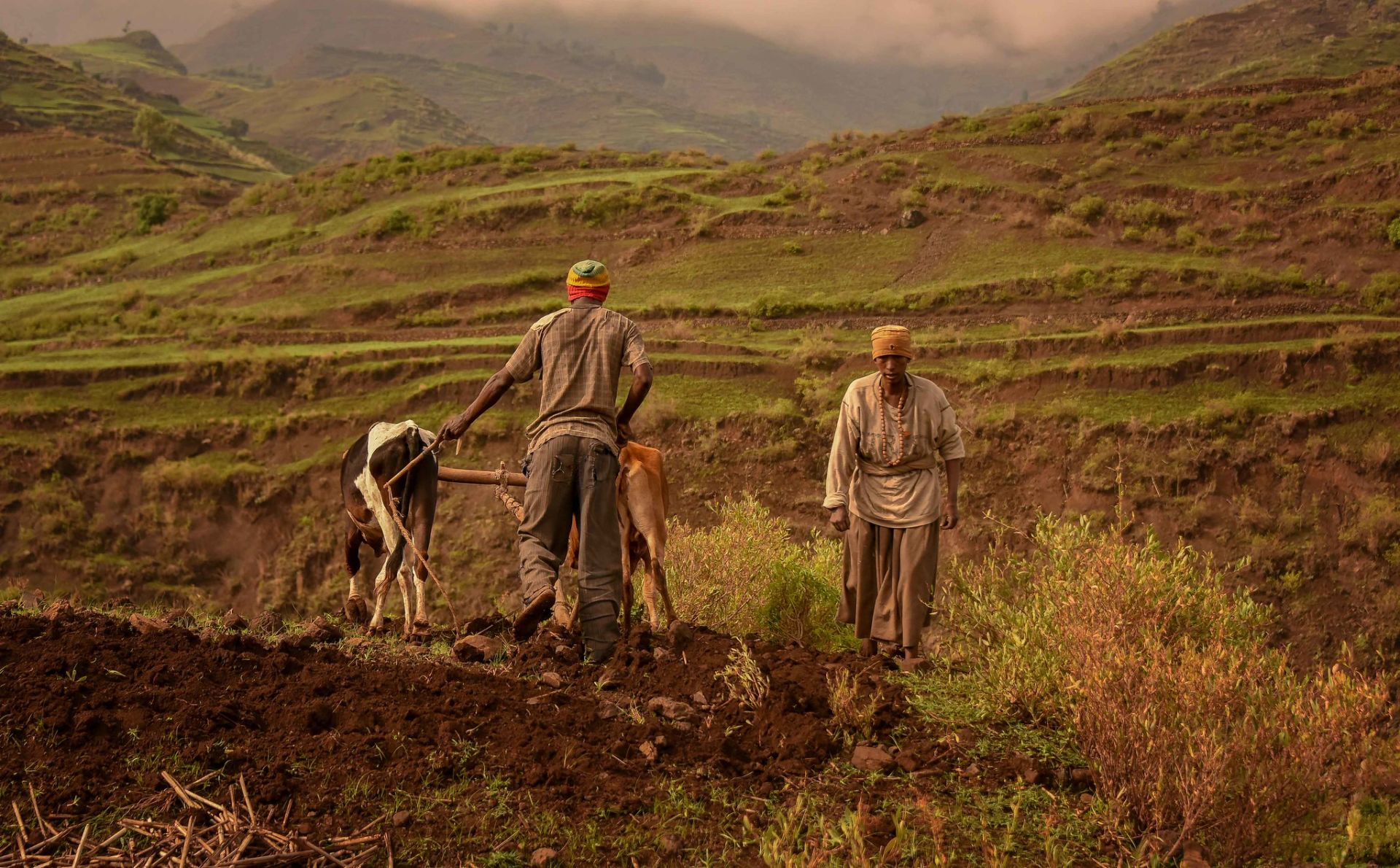
Women who gain ownership of agricultural land may face social restrictions that make them dependent on men for farming. For example, in Ethiopia’s Amhara Region, a traditional ban on women plowing the land forced women who are heads of their households to cede control of harvesting, including a significant part of the harvest, to sharecropping plowmen who are occasionally their former husbands. This occurs despite these women having formal titles. Under Ethiopian law, tenure security is a use-it-or-lose-it proposition, which means women with land titles who are too poor to hire farm laborers or lack male family members available to plow their fields are left with limited options. They often opt to have their land cultivated or rented by others and end up reaping little benefit from the harvest and become vulnerable to unlawful evictions. Similarly, in certain regions of India, particularly in the north, a taboo against women plowing means that women have to hire men with tractors or draft animals to cultivate their land, for which they are often required to pay in cash in advance. No such demand for advance payment is made of male farmers, who are generally deemed creditworthy.
Customary norms often dictate that the husband exert greater control or decision-making power over the family holding, even when jointly titled. Important agricultural decisions or potential sales are made by the husband, even as the wives coordinate day-to-day management. In Azerbaijan, where state land was distributed to all former members of a collective or state farm regardless of gender, women acknowledged that men still make most of the decisions about land. A study of six countries in sub-Saharan Africa by Vanya Slavchevska, Ana Paula de la O Campos, and Chiara Brunelli found that in some countries, such as Nigeria, men solely manage more than half of the jointly owned plots, compared to less than a third of the plots that are jointly managed and 19 percent that are managed solely by women. In other instances, in Ethiopia, for example, when a marriage ends in divorce, women often receive less fertile, smaller parcels of land, and are sometimes paid a small sum of money to give up their land rights.
When a woman’s husband dies, she may be barred by customary norms on inheritance from claiming her share in jointly titled land. In cases where property is jointly titled, but is originally family or clan land and the family considers itself to have superior rights over the widow, the land will often go to the widow’s sons or other male relatives of her deceased husband. The widow, despite having her name on the title, will be treated like any other family member rather than a rightful owner. Under certain customary practices, the only option available to the widow if she wants to keep the land is to marry a brother-in-law or other close male relative of her deceased husband. Otherwise, she ends up being dispossessed and landless.
Related Articles: Women’s Rights in Turkey | Woman’s Right to Property After Divorce in Kenya
Tenure insecurity can also stem from marriage and family laws, which entitle husbands to manage marital property. These laws exist in countries such as Argentina, Cameroon, Chile, the Democratic Republic of the Congo, Honduras, Nicaragua, and the Republic of the Congo. In these countries, even if both spouses’ names are on the property title, the husband is considered the legal administrator and primary decision-maker.
Research shows that female farmers with land titles face more constraints than male farmers. They have less access to technical assistance, irrigation, technology, and extension and credit services. For example, a baseline assessment of regions covered by a rural development program in Ecuador shows that while women made up 21 percent of the farmers, only 15.3 percent of them had access to modern technology, 12.4 percent had access to credit, and 9.4 percent had passed training programs. A survey by the Food and Agriculture Organization of the United Nations (FAO) of organizations providing extension services (such as training, technology transfer, and agricultural inputs such as improved seeds) in 97 countries reveals that only 5 percent of these resources were directed at women. And while all smallholders have difficulty accessing credit and other financial services, in most countries it is harder for women to do so. The FAO study further shows that the share of female smallholders who can access credit lags 5–10 percentage points behind the rate for men.
Women may end up with debt they cannot repay and risk being dispossessed of their land.
Women with formal titles who wish to use the title as collateral for loans may not necessarily have a clear understanding of its implications, leaving them vulnerable to losing their land. Kelly Askew and Rie Odgaard’s recently published study of the gender impacts of land formalization programs in Tanzania shows that women want to gain land titles and then use their title deeds to access credit. However, these loans would not be used to invest in the land to improve yields or start small businesses. Instead, the money would be used to pay for their children’s education. Many banks decline to grant loans on the basis of rural land titles for this reason, so money lenders are filling the gap. Women are entrapped due to the likelihood of higher rates of interest on these loans and the fact that the educational investment is unlikely to yield any monetary return during the term of the loan, or, given increasing rates of unemployment, yield any return at all. Women may end up with debt they cannot repay and risk being dispossessed of their land.
Titling Runs Counter to Collective Tenure
Another significant concern related to focusing solely on titling is that individual titling is at odds with many indigenous peoples’ way of living. As Miskita indigenous leader Myrna Cunningham explains, indigenous peoples view their collectively held ancestral lands not just as the basis of their livelihoods and economic security, but also as the center of their identities, culture, and economic and social systems. Indigenous women assert that this unique relationship with the land demands that the land be formally secured and held under a communal property framework, while they retain their rights to use and benefit from land as individuals within the community. Indigenous women recognize, experience, and challenge patriarchal traditions that impinge on their rights to land and other resources, and often see individual land titling as counterproductive.
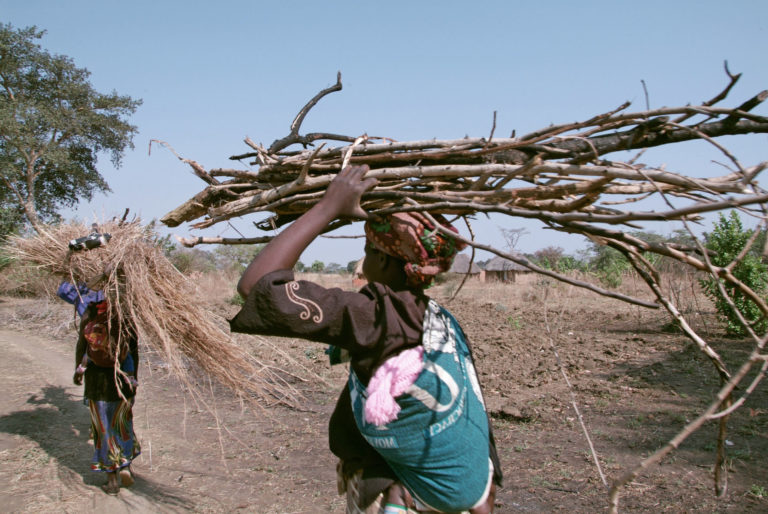
Indigenous land tenure systems often involve diverse uses and rights over the same parcel of land held by individuals, households, or groups within the community. The same plot can be used to cultivate a food crop or graze livestock, depending upon the season. Members of the community may have access to resources, such fruit trees, at certain times. Formalizing these rights can lead to the exclusion of other legitimate users with lesser interests, conflict between various users, and the erosion of social institutions. For example, a program to formalize group ranches in parts of the Kenyan rangelands disrupted reciprocal access arrangements between Maasai groups, which were part of their coping strategies during times of drought and other climate challenges. Women lamented subsequent restrictions on access to land for grazing and gathering fuelwood, which increased their daily burdens and led to increased conflicts over trespassing.
Women are disproportionately affected when title formalization excludes common resources. It has long been established, by Bina Agarwal and others, that women rely heavily on the commons. The commons include communal forests and woodlots that women use to fulfill their domestic responsibilities, such as collecting water, firewood, and fodder for household use, and gathering non-timber forest products such as wild fruits, honey, mushrooms, and medicinal plants for family nutrition and supplemental livelihood. This is particularly seen among poor households and those with small agricultural plots. In cases where the state deems the commons as idle or marginal lands or claims them as part of public or state land, women and their communities lose an integral benefit of collectively held land. However, even in instances where the commons are formally recognized as part of the lands held collectively by the community, if women are shut out of the officially recognized governance body then the perception or experience of tenure security may become low.
Rather than individual titling, indigenous women call for full recognition of their collectively held lands. They also want the full inclusion and participation of women in community governance and leadership structures and decision-making forums, whether statutory or customary.
Identifying Promising Practices
Women’s experiences around the world show that tenure security is a broader concept than merely titling in women’s names. The sources of tenure insecurity must be addressed through a range of interventions by different actors and at different levels if women are to benefit from land redistribution and formalization programs.
A good starting point would be to establish gender-equitable normative frameworks, a pivotal role played by the state. These include repealing discriminatory provisions in family and inheritance laws that exclude women from important decisions regarding land, such as inheriting land or land entitlement upon divorce. For women who live on collectively held land, these gender-equitable frameworks include recognizing women as full co-owners or members of the community in their individual capacity, not simply as a member of a household or family that is deemed as the rights holder. Governments can institute gender quotas in land administration bodies like dispute resolution bodies, from the national down to the village level, to increase women’s representation and voice in land governance. This includes membership in communal governance structures in collectively held land. However, as WRI’s previous research shows, gender quotas must be accompanied by mechanisms such as quorum and voting requirements to ensure that women can effectively participate. In addition, formalization programs on indigenous or community-held lands that integrate conservation or protection objectives must also balance these objectives with the livelihood needs and practices of women and their communities.
Additionally, land redistribution and formalization interventions must incorporate gender-equitable outcomes in the program design and implementation measures and procedures. A first step is ensuring program design is underpinned by an analysis of the legal and customary frameworks, local context, and the sites of inequality for women, such as marital status (including polygamous marriages and consensual unions), ethnicity, class, customary norms, religion, education, mobility, etc. Targeted measures may include establishing a gender desk or focal point that will coordinate and monitor progress and achievement of gender goals. For example, Ethiopia’s Second Level Land Certification Process created the position of social development officer as part of the field team. This officer is charged with identifying women’s needs and addressing those needs in the various stages of the program. Other measures include public awareness and information dissemination activities that target both women and men and aim to help them better understand the objectives of the intervention and the benefits of secure tenure for women; involving women in land demarcation, boundary setting, and other procedures attendant to mapping and registration; and ensuring that women’s names are included on jointly owned or household land.
Promising practices in this area include tapping women to spearhead household data collection and public discussions related to the intervention; elevating the status of women to be equal players in the land certification project (e.g., Zambia); and including the photographs of both spouses in jointly held titles (e.g., Tanzania and Ethiopia), the names of children (as heirs), and a photograph of the whole family (e.g., Zambia). The intervention must also ensure that dispute resolution mechanisms are in place and accessible by women, taking into consideration their lower levels of literacy, time and mobility constraints, and social norms that inhibit them from pursuing justice. Including female members in the local dispute resolution bodies and instituting a gender desk or gender focal point can help support women’s access to justice.
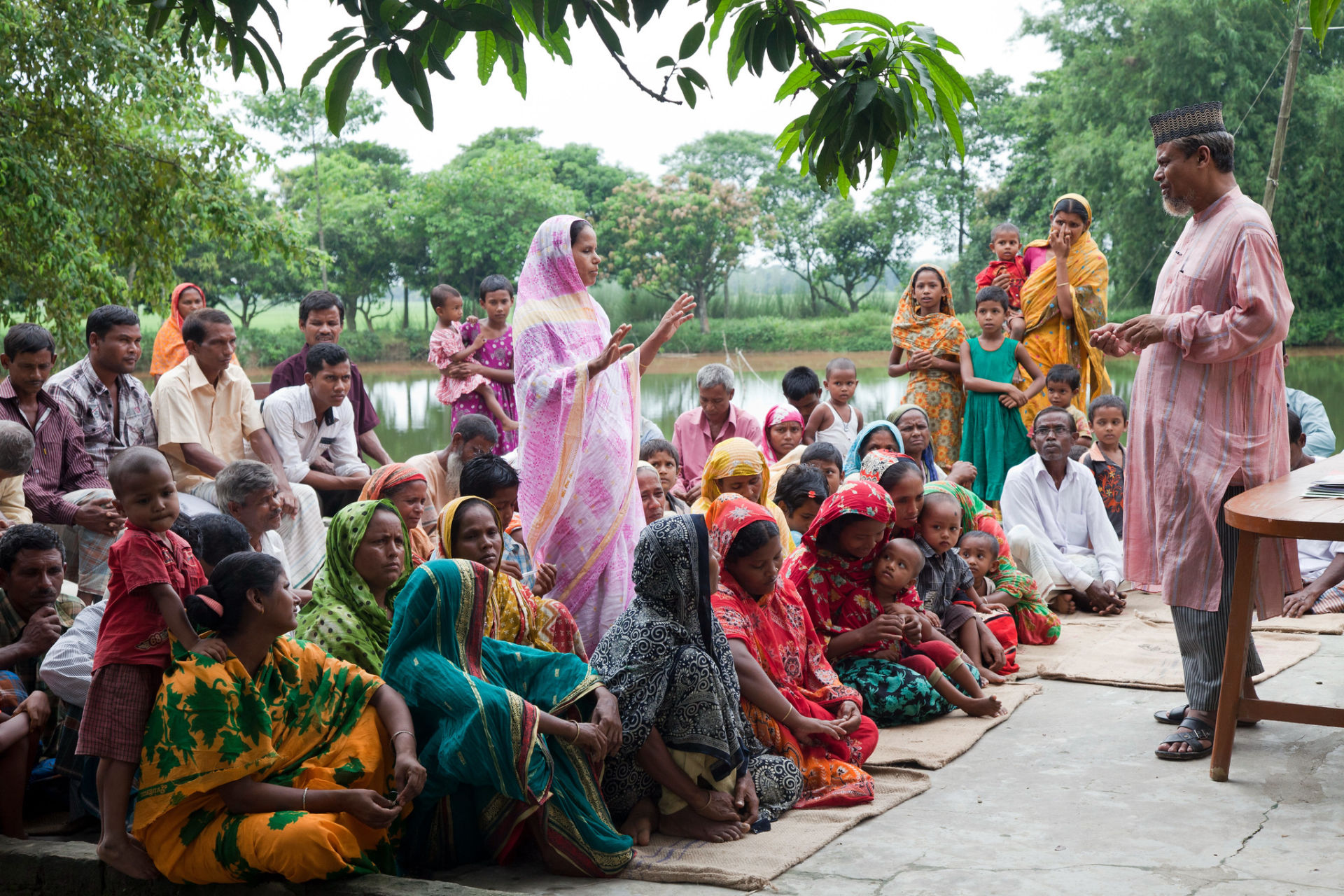
Interventions to document or devolve ownership or usufruct rights on indigenous and collectively held lands must ensure that the program design and its implementation process have clear guidance on how to include women and other marginalized groups in the community and account for their concerns and needs. A failure to do so might lead the intervention to perpetuate existing gender biases and internal social differentiation practices. For example, the creation of group constitutions or internal bylaws as part of the registration process can serve as an opportunity to review customary norms and governance arrangements that are inequitable to women (e.g., Uganda and Peru).
Finally, to achieve tenure security, the reform process should not be deemed complete after issuance of land titles or certificates to women or the issuance of group titles for collectively held lands. Given women’s limited access to resources, there is a need for ancillary interventions that address their livelihood concerns. These include training and capacity building, including on new technologies and production systems, and assistance in procuring production inputs and accessing marketing facilities. In this regard, NGOs and women’s organizations can supplement the efforts of government and development agencies. In addition, research using sex-disaggregated indicators to measure the realization of women’s land rights, not just in terms of ownership but also other dimensions of tenure security, can help track progress in achieving women’s land tenure security.
Securing Land Tenure for Women
The evidence on the ground establishes that secure land rights for women are key to achieving gender equality. Tenure security for women acts as a catalyst for a range of economic and social benefits, including inclusive growth, food security, poverty reduction, and more democratic and resilient communities. The caveat is that it must be done right.
Any policy or intervention to secure women’s land rights must also address women’s reality on the ground, including their lack of access to resources and information, unequal status in land and family laws, discriminatory customary norms, and limited ability to claim or enforce rights and seek justice.
Focusing on title or documentation alone, without addressing persistent barriers faced by women, not only misses the mark, but could also end up being counterproductive. Any policy or intervention to secure women’s land rights must also address women’s reality on the ground, including their lack of access to resources and information, unequal status in land and family laws, discriminatory customary norms, and limited ability to claim or enforce rights and seek justice. Examples from around the world of how to provide secure land rights for women vary from simple changes such as adding women’s photographs to the title or certificate to integrating gender outcomes in program design, implementation, and evaluation; improving women’s legal status; and showing evidence that protecting women’s land rights uplifts the entire community. There are considerable benefits to be had from securing women’s land tenure; it is high time it was secured globally.
Editor’s Note: The opinions expressed here by Impakter.com columnists are their own, not those of Impakter.com— In the Featured Photo: An IITA researcher harvests a cassava root from a farm in Abuja, Nigeria. Cassava is the second most important food crop in the least-developed countries, and the fourth most important in developing countries. Over half of annual cassava production comes from Africa — Featured Photo Credit: ©IFPRI/Milo Mitchell


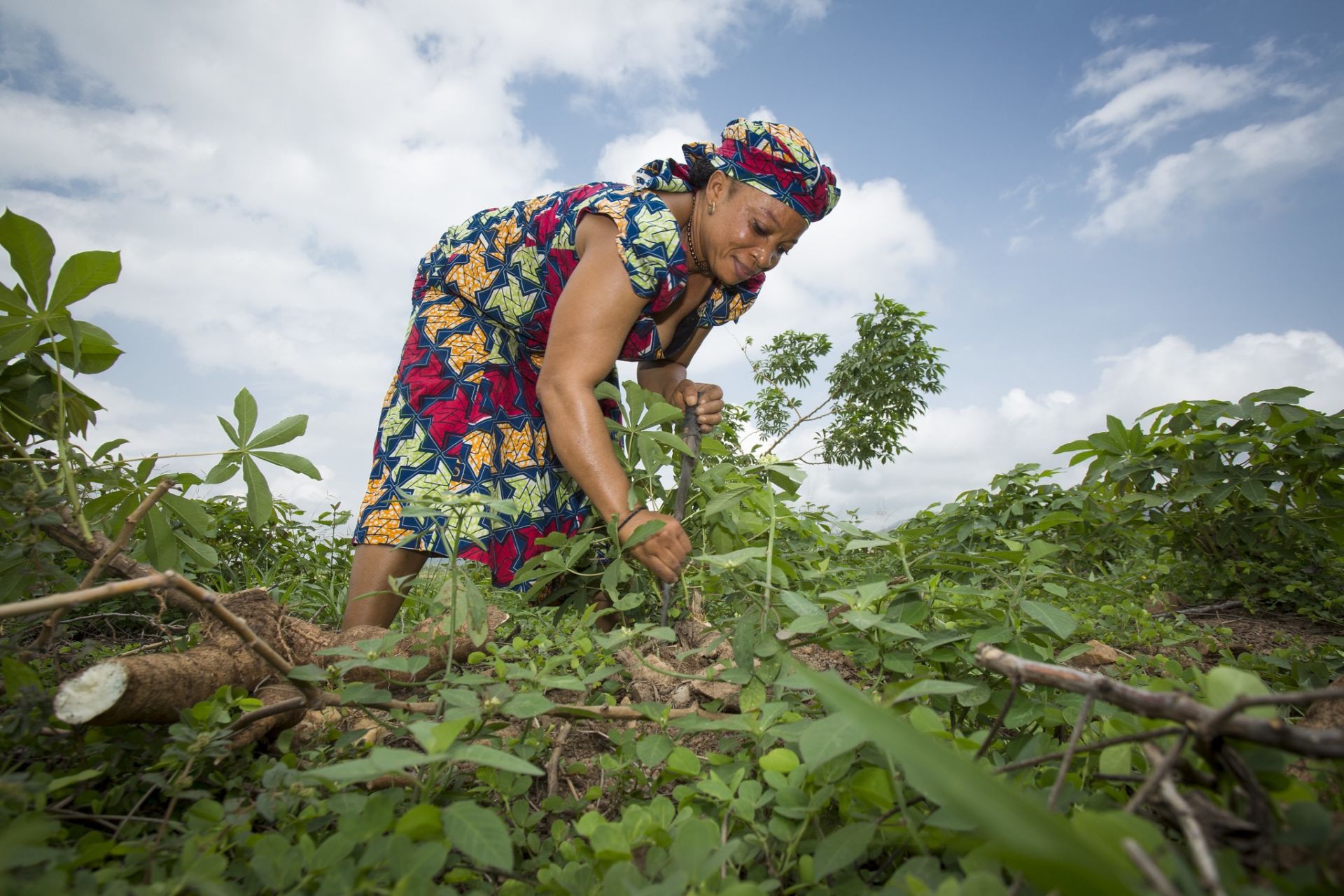


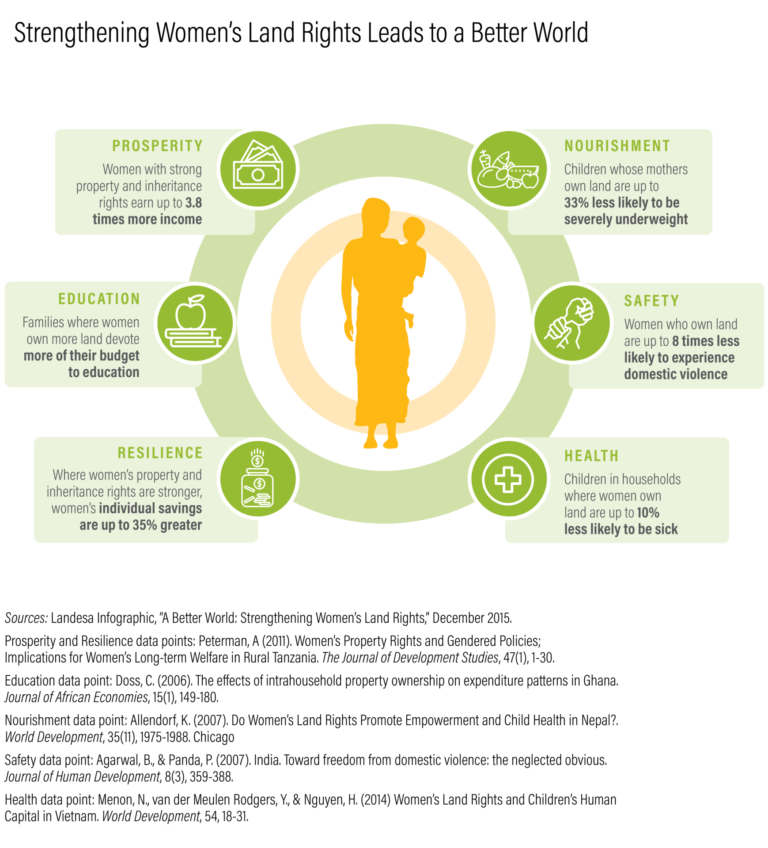
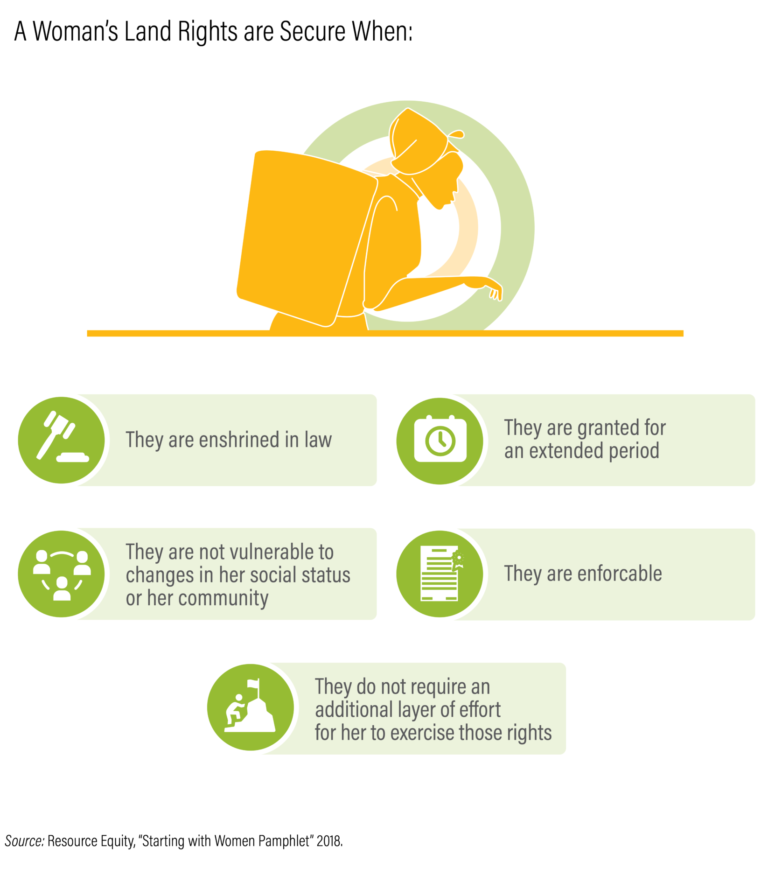







Secure land rights for women is recognized as critical for achieving the Sustainable Development Goals (SDGs), particularly for eradicating poverty and ending hunger and gender equality (Goals 1, 2 and 5). Progress has been made in securing women’s land rights through titling, but the challenges women face require a more robust range of interventions to ensure that they can make decisions on land use and reap benefit from the land. These include more gender-equitable laws as well as training and capacity-building for women. Secure land rights uplifts the whole community and moves the world closer to realizing the SDGs.